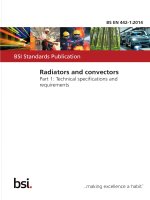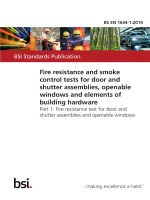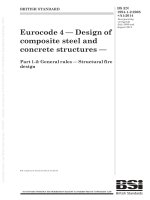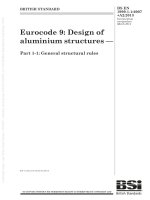Bsi bs en 61910 1 2014
Bạn đang xem bản rút gọn của tài liệu. Xem và tải ngay bản đầy đủ của tài liệu tại đây (1.5 MB, 36 trang )
BS EN 61910-1:2014
BSI Standards Publication
Medical electrical equipment —
Radiation dose documentation
Part 1: Radiation dose structured reports
for radiography and radioscopy
BRITISH STANDARD
BS EN 61910-1:2014
National foreword
This British Standard is the UK implementation of EN 61910-1:2014. It is
identical to IEC 61910-1:2014.
The UK participation in its preparation was entrusted by Technical
Committee CH/62, Electrical Equipment in Medical Practice, to
Subcommittee CH/62/2, Diagnostic imaging equipment.
A list of organizations represented on this committee can be obtained on
request to its secretary.
This publication does not purport to include all the necessary provisions of
a contract. Users are responsible for its correct application.
© The British Standards Institution 2015.
Published by BSI Standards Limited 2015
ISBN 978 0 580 77966 4
ICS 11.040.50
Compliance with a British Standard cannot confer immunity from
legal obligations.
This British Standard was published under the authority of the
Standards Policy and Strategy Committee on 28 February 2015.
Amendments/corrigenda issued since publication
Date
Text affected
BS EN 61910-1:2014
EUROPEAN STANDARD
EN 61910-1
NORME EUROPÉENNE
EUROPÄISCHE NORM
November 2014
ICS 11.040.50
English Version
Medical electrical equipment - Radiation dose documentation Part 1: Radiation dose structured reports for radiography and
radioscopy
(IEC 61910-1:2014)
Appareils électromédicaux - Documentation sur la dose de
rayonnement - Partie 1: Rapports structurés sur la dose de
rayonnement pour la radiographie et la radioscopie
(CEI 61910-1:2014)
Medizinische elektrische Geräte - Dokumentation der
Strahlungsdosis - Teil 1: Strukturierte StrahlungsdosisBerichte für die Radiographie und Radioskopie
(IEC 61910-1:2014)
This European Standard was approved by CENELEC on 2014-10-29. CENELEC members are bound to comply with the CEN/CENELEC
Internal Regulations which stipulate the conditions for giving this European Standard the status of a national standard without any alteration.
Up-to-date lists and bibliographical references concerning such national standards may be obtained on application to the CEN-CENELEC
Management Centre or to any CENELEC member.
This European Standard exists in three official versions (English, French, German). A version in any other language made by translation
under the responsibility of a CENELEC member into its own language and notified to the CEN-CENELEC Management Centre has the
same status as the official versions.
CENELEC members are the national electrotechnical committees of Austria, Belgium, Bulgaria, Croatia, Cyprus, the Czech Republic,
Denmark, Estonia, Finland, Former Yugoslav Republic of Macedonia, France, Germany, Greece, Hungary, Iceland, Ireland, Italy, Latvia,
Lithuania, Luxembourg, Malta, the Netherlands, Norway, Poland, Portugal, Romania, Slovakia, Slovenia, Spain, Sweden, Switzerland,
Turkey and the United Kingdom.
European Committee for Electrotechnical Standardization
Comité Européen de Normalisation Electrotechnique
Europäisches Komitee für Elektrotechnische Normung
CEN-CENELEC Management Centre: Avenue Marnix 17, B-1000 Brussels
© 2014 CENELEC All rights of exploitation in any form and by any means reserved worldwide for CENELEC Members.
Ref. No. EN 61910-1:2014 E
BS EN 61910-1:2014
EN 61910-1:2014
-2-
Foreword
The text of document 62B/948/FDIS, future edition 1 of IEC 61910-1, prepared by SC 62B “Diagnostic
imaging equipment” of IEC/TC 62 “Electrical equipment in medical practice" was submitted to the
IEC-CENELEC parallel vote and approved by CENELEC as EN 61910-1:2014.
The following dates are fixed:
•
latest date by which the document has to be
implemented at national level by
publication of an identical national
standard or by endorsement
(dop)
2015-07-29
•
latest date by which the national
standards conflicting with the
document have to be withdrawn
(dow)
2017-10-29
Attention is drawn to the possibility that some of the elements of this document may be the subject of
patent rights. CENELEC [and/or CEN] shall not be held responsible for identifying any or all such
patent rights.
Endorsement notice
The text of the International Standard IEC 61910-1:2014 was approved by CENELEC as a European
Standard without any modification.
BS EN 61910-1:2014
EN 61910-1:2014
-3-
Annex ZA
(normative)
Normative references to international publications
with their corresponding European publications
The following documents, in whole or in part, are normatively referenced in this document and are
indispensable for its application. For dated references, only the edition cited applies. For undated
references, the latest edition of the referenced document (including any amendments) applies.
NOTE 1 When an International Publication has been modified by common modifications, indicated by (mod), the relevant
EN/HD applies.
NOTE 2 Up-to-date information on the latest versions of the European Standards listed in this annex is available here:
www.cenelec.eu
Publication
Year
Title
EN/HD
Year
IEC 60601-1
2005
+A1
2012
Medical electrical equipment Part 1: General requirements for basic
safety and essential performance
EN 60601-1
+ corr. Mars
+A11
+A1
+A1/corr. July
2006
2010
2011
2013
2014
+A12
2014
IEC 60601-1-3
2008
Medical electrical equipment EN 60601-1-3
Part 1-3: General requirements
+ corr. Mars
for basic safety and essential performance
- Collateral Standard: Radiation protection
in diagnostic X-ray equipment
+A1
+A1/corr. May
2008
2010
+A1
2013
IEC 60601-2-43
2010
Medical electrical equipment EN 60601-2-43
Part 2-43: Particular requirements for the + corr. July
basic safety and essential performance of
X ray equipment for interventional
procedures
2010
2014
IEC 60601-2-54
2009
Medical electrical equipment EN 60601-2-54
Part 2-54: Particular requirements for the
basic safety and essential performance of
X-ray equipment for radiography and
radioscopy
2009
IEC/TR 60788
2004
Medical electrical equipment - Glossary of defined terms
-
2013
2014
–2–
BS EN 61910-1:2014
IEC 61910-1:2014 © IEC 2014
CONTENTS
INTRODUCTION ..................................................................................................................... 6
1
Scope .............................................................................................................................. 7
2
Normative references ...................................................................................................... 7
3
Terms and definitions ...................................................................................................... 8
4
Units and their DICOM storage formats ........................................................................... 9
5
General requirements ...................................................................................................... 9
5.1
* Conformance levels .............................................................................................. 9
5.1.1
General ........................................................................................................... 9
5.1.2
Basic dose documentation ............................................................................... 9
5.1.3
Extended dose documentation ....................................................................... 10
5.2
Data flow .............................................................................................................. 12
5.2.1
General ......................................................................................................... 12
5.2.2
R DSR STREAMING TRANSMISSION ...................................................................... 12
5.2.3
R DSR END OF PROCEDURE TRANSMISSION .......................................................... 12
Annex A (informative) General guidance and rationale ......................................................... 13
A.1
A.2
A.3
Annex B
General guidance .................................................................................................. 13
Rationale for specific clauses and subclauses ...................................................... 13
Biological background ........................................................................................... 14
(informative) DICOM and IHE outline ..................................................................... 16
B.1
B.2
B.3
Annex C
DICOM objects...................................................................................................... 16
IHE profiles ........................................................................................................... 17
IHE Radiation Exposure Monitoring Profile ............................................................ 17
(informative) Glossary of DICOM data elements .................................................... 19
Annex D (informative) Coordinate systems and their applications ........................................ 23
D.1
D.2
D.3
D.4
D.5
D.6
Annex E
General ................................................................................................................. 23
Equipment-specific information ............................................................................. 23
Patient location and orientation ............................................................................. 24
Single procedure step patient dose estimates ....................................................... 24
Multiple procedure step patient dose estimates ..................................................... 24
Numeric and geometric expression of uncertainty ................................................. 25
(informative) Geometry and positions in DICOM..................................................... 26
E.1
Patient positions ................................................................................................... 26
E.2
Positioner primary and secondary angles .............................................................. 26
E.3
P ATIENT SUPPORT positions .................................................................................... 28
E.4
Projection imaging geometries .............................................................................. 29
Bibliography .......................................................................................................................... 30
Index of defined terms used in this particular standard .......................................................... 31
Figure E.1 − P ATIENT positions for X- RAY EQUIPMENT with PATIENT SUPPORT such as in
X-ray angiography. ............................................................................................................... 26
Figure E.2 − Positioner primary angle for patient position “recumbent − head
first − supine” ........................................................................................................................ 27
Figure E.3 − Positioner secondary angle for patient position “recumbent − head
first − supine” ........................................................................................................................ 27
BS EN 61910-1:2014
IEC 61910-1:2014 © IEC 2014
–3–
Figure E.4 − Positioner primary angle for patient position “recumbent − head
first − prone” ......................................................................................................................... 28
Figure E.5 − Positioner secondary angle for patient position “recumbent − feet
first − supine” ........................................................................................................................ 28
Figure E.6 − Position vectors defining the position of the PATIENT SUPPORT ........................... 29
Figure E.7 − Distance-related DICOM attributes for X- RAY EQUIPMENT with C-arm and
PATIENT SUPPORT such as in X-ray angiography ..................................................................... 29
Table C.1 – DICOM data elements ........................................................................................ 19
–6–
BS EN 61910-1:2014
IEC 61910-1:2014 © IEC 2014
INTRODUCTION
Documentation of the amount of IONIZING RADIATION used during a RADIOLOGICAL procedure is
valuable for several reasons. For all procedures dose documentation provides information
needed to estimate radiogenic risk to the population. It also plays a role in general
institutional quality assurance by providing data for performance validation against
established RADIATION dose reference levels. Detailed documentation makes a significant
contribution to clinical management of PATIENTS following those interventional procedures that
might induce tissue reactions.
The transition from imaging on film to digital imaging opened the possibility of automatically
recording dose and other data with the images. The Digital Imaging and Communications in
Medicine (DICOM) protocol traditionally provides some relevant facilities for doing this in
image headers. This has had several limitations. The most obvious of these is the lack of a
means for storing dose data without storing images. Thus, radioscopic data was seldom
stored; and no dose data was stored if the images were not stored.
Improving dose documentation was addressed jointly by the International Electrotechnical
Commission (IEC) and the DICOM Standards Committee. Supplement 94 to the DICOM
standard was approved in 2005 and incorporated since the 2006 edition of the standard. The
DICOM standard now provides the technical format needed to store the entire description of
the dose used to perform a single imaging procedure. This first edition of IEC 61910-1
replaces the Publicly Available Specification (PAS) and can become a companion document
to IEC 60601-2-43 and IEC 60601-2-54. It defines the reporting of relevant RADIATION dose
information and establishes conformance levels for dose documentation, to be referred to by
requirements in the aforementioned equipment standards. The conformance levels represent
a combination of increasing PATIENT risk and an increasing interest in quality assurance. The
basic dose documentation conformance level is intended for X- RAY EQUIPMENT that produces
dose levels below significant deterministic thresholds for all INTENDED USES . The extended
dose documentation conformance level is intended for X- RAY EQUIPMENT used for procedures
that could cause significant tissue reactions.
The process resulting from this work is summarized as follows. Information is gathered into a
radiation dose structured report (RDSR). This new object is designed to be stored in a picture
archiving and communication system (PACS), in a medical informatics system, in a
freestanding dose management workstation, or in the X- RAY EQUIPMENT itself. A performed
procedure step (resulting in a single RDSR ) is related to the RADIATION applied to a single
PATIENT by a single piece of X- RAY EQUIPMENT in one session. The data structure permits the
transfer of entire studies at once or the streaming of information per individual IRRADIATION EVENT . The Integrating the Healthcare Enterprise (IHE) Radiation Exposure Monitoring (REM)
Profile describes an IT architecture for the creation, storage, analysis and distribution
(including submission to centralized registries) of DICOM RDSR objects.
BS EN 61910-1:2014
IEC 61910-1:2014 © IEC 2014
–7–
MEDICAL ELECTRICAL EQUIPMENT –
RADIATION DOSE DOCUMENTATION –
Part 1: Radiation dose structured reports
for radiography and radioscopy
1
Scope
This International Standard applies to RADIATION DOSE STRUCTURED REPORTS ( RDSR ) produced
by X- RAY EQUIPMENT that falls within the scope of IEC 60601-2-43:2010 or IEC 60601-254:2009.
NOTE 1 The intent is to develop and publish similar documents for other X-ray imaging modalities capable of
producing RDSR s.
NOTE 2 This document does not impose specific requirements on the accuracy of the reported or displayed data.
Existing standards or regulations can have applicable requirements for accuracy and precision.
This standard provides specific units and quantities and prescribes data storage formats.
NOTE 3 The data formats are specified such that the numerical uncertainty attributable to the format is likely to
be small compared to other data uncertainties.
NOTE 4
This document does not present any requirements on the form of display of dose information to
or other individuals.
OPERATORS
The objective of this International Standard is to specify the minimum dataset to be used for
reporting dosimetric and related information associated with the production of projection
RADIOLOGICAL IMAGES .
NOTE 5 The data fields and report structure are intended to facilitate the collection of dosimetric data useful for:
management of procedures delivering significant dose, facility quality programs, establishment of reference levels,
education.
NOTE 6
2
A public structure facilitates data analysis by any appropriate individual or organization.
Normative references
The following documents, in whole or in part, are normatively referenced in this document and
are indispensable for its application. For dated references, only the edition cited applies. For
undated references, the latest edition of the referenced document (including any
amendments) applies.
IEC 60601-1:2005, Medical electrical equipment – Part 1: General requirements for basic
safety and essential performance
IEC 60601-1:2005/AMD1:2012
IEC 60601-1-3:2008, Medical electrical equipment – Part 1-3: General requirements for basic
safety and essential performance – Collateral Standard: Radiation protection in diagnostic Xray equipment
IEC 60601-1-3:2008/AMD1:2013
IEC 60601-2-43:2010, Medical electrical equipment – Part 2-43: Particular requirements for
the basic safety and essential performance of X-ray equipment for interventional procedures
–8–
BS EN 61910-1:2014
IEC 61910-1:2014 © IEC 2014
IEC 60601-2-54:2009, Medical electrical equipment – Part 2-54: Particular requirements for
the basic safety and essential performance of X-ray equipment for radiography and
radioscopy
IEC TR 60788:2004, Medical electrical equipment – Glossary of defined terms
3
Terms and definitions
For the purposes of this document, the terms and definitions given in IEC 60601-1:2005 +
IEC 60601-1:2005/AMD1:2012, IEC 60601-1-3:2008 + IEC 60601-1-3:2008/AMD1:2013,
IEC 60601-2-43:2010, IEC 60601-2-54:2009, IEC TR 60788:2004 and the following apply.
3.1
* IRRADIATION - EVENT
LOADING of X - RAY EQUIPMENT caused by a single continuous actuation of the equipment’s
IRRADIATION SWITCH , from the start of the LOADING TIME of the first pulse until the LOADING TIME
trailing edge of the final pulse
Note 1 to entry: An IRRADIATION - EVENT can produce a single image (e.g. chest-radiograph) or a series of images
(e.g. RADIOSCOPY , Cine or DSA acquisition).
Note 2 to entry: The RADIOLOGICAL IMAGES resulting from an IRRADIATION - EVENT can be stored in the X - RAY
EQUIPMENT or image archive or not.
Note 3 to entry: Corresponding statement in the DICOM standard [1] 1 PS 3.16, Annex D: An IRRADIATION - EVENT is
the occurrence of radiation being applied to a patient in a single continuous time-frame between the start (release)
and the stop (cease) of the irradiation. Any on-off switching of the irradiation source during the event shall not be
treated as separate events, rather the event includes the time between start and stop of irradiation as triggered by
the user. E.g., a pulsed fluoro X-ray acquisition shall be treated as a single IRRADIATION - EVENT .
Note 4 to entry:
203.4.101.3.
LOADING TIME
is defined in IEC 60601-1-3:2008, 3.37, and described in IEC 60601-2-54:2009,
3.2
ACTOR
information system or component of information system that produces, manages, or acts on
categories of information required by operational activities in the RESPONSIBLE ORGANIZATION
Note 1 to entry:
Details on IHE terms are provided in Clauses B.2 and B.3
Note 2 to entry:
See IHE Radiology Technical Framework:2011 [2], Volume 1, Section 1.6.1.
3.3
RADIATION DOSE STRUCTURED REPORT
RDSR
structured digital record of RADIATION
dose delivered to a PATIENT during a RADIOLOGICAL
procedure, encoded as DICOM dose structured report object
3.4
* RDSR STREAMING TRANSMISSION
process of sending the current partial RDSR after completion of each IRRADIATION - EVENT
3.5
RDSR END OF PROCEDURE TRANSMISSION
process of sending a final RDSR after completion or discontinuation of a RADIOLOGICAL
procedure
Note 1 to entry:
Resetting the dose indicators defines the end of the previous RADIOLOGICAL procedure.
____________
1
Numbers in square brackets refer to the Bibliography.
BS EN 61910-1:2014
IEC 61910-1:2014 © IEC 2014
4
–9–
Units and their DICOM storage formats
The numerical values of all quantities shall be stored in a format such that storage rounding
introduces less than 1,0 % total additional uncertainty.
5
General requirements
5.1
* Conformance levels
5.1.1
General
The RDSR shall conform to one of the following levels: basic dose documentation or extended
dose documentation.
NOTE 1 The basic dose documentation conformance level is intended for X - RAY EQUIPMENT that produces dose
levels below significant deterministic thresholds for all INTENDED USES . The extended dose documentation
conformance level is intended for X - RAY EQUIPMENT used for procedures that could cause significant tissue
reactions.
NOTE 2 In case of equipment component failure leading to incomplete RDSR , these are preferred over no RDSR for
the period of such failure.
5.1.2
Basic dose documentation
The RDSR conforming to basic dose documentation shall contain, at least, the following
elements (DICOM Type 1 or 2 or “M” or “U”) in the applicable TID and RDSR header
depending on the type of X- RAY EQUIPMENT :
NOTE
Applicability of TID is defined in the condition statements in [1] PS 3.16.
In TID 10004 (Accumulated Projection X-Ray Dose):
•
Dose (RP) Total
•
Dose Area Product Total
•
Distance Source to Reference Point
•
If the equipment is providing this information:
–
•
Total Number of Radiographic Frames
If there was RADIOSCOPY :
–
Total Fluoro Time
TID 10006 (Accumulated Cassette-based Projection Radiography Dose):
•
Total Number of Radiographic Frames
In TID 10007 (Accumulated Integrated Projection Radiography Dose)
•
Dose Area Product Total
•
If the equipment is providing this information:
–
Total Number of Radiographic Frames
In the RDSR header:
•
Device Serial Number
•
Manufacturer
•
Manufacturer’s Model Name
•
Software Versions
10
ã
BS EN 61910-1:2014
IEC 61910-1:2014 â IEC 2014
Date, Time for the Series
The RDSR conforming to basic dose documentation should contain, in addition, the following
elements (DICOM Type 2 or 3 or “U”):
In the RDSR header:
•
Institution Name
•
Patient’s Size
•
Patient’s Weight
•
Patient’s Name
•
Patient ID
•
Patient’s Birth Date
•
Referenced Request Sequence (with Requested Procedure Description or Requested
Procedure Code Sequence)
•
Performed Procedure Code Sequence
In TID 10001 (Projection X-Ray Radiation Dose)
•
Use TID 1002 (Observer Context) with “Person Observer’s Role in this Procedure” set to
“Irradiation Administering”
In TID 10002 (Accumulated X-Ray Dose):
•
Calibration Factor(s)
•
Calibration Date
•
Calibration Responsible Party
•
Calibration Protocol
In TID 10003 (Irradiation Event X-Ray Data):
•
Acquisition Protocol
•
DateTime Started
•
Irradiation Event Type
NOTE 1
The Dose Measurement Device is an independent device with a traceable calibration.
NOTE 2 The Calibration Responsible Party element in the Calibration data contains the information about the
party responsible for the most recent calibration service.
NOTE 3 The RDSR contains the values displayed at the equipment, no Calibration Factor delivered in TID 10002
is applied.
5.1.3
Extended dose documentation
The RDSR conforming to extended dose documentation shall comply with 5.1.2 and shall
contain, in addition, the following elements (DICOM Type 2 or 3 or “M” or “U”):
In TID 10001 (Projection X-Ray Radiation Dose)
•
Use TID 1002 (Observer Context) with “Person Observer’s Role in this Procedure” set to
“Irradiation Administering”
In TID 10002 (Accumulated X-Ray Dose):
•
Calibration Factor(s)
•
Calibration Date
BS EN 61910-1:2014
IEC 61910-1:2014 â IEC 2014
ã
Calibration Responsible Party
ã
Calibration Protocol
11 –
In TID 10003 (Irradiation Event X-Ray Data) and sub-templates:
•
Acquisition Protocol
•
DateTime Started
•
Irradiation Event Type
•
Dose Related Distance Measurements (“Distance Source to Reference Point”)
•
Dose Related Distance Measurements (“Distance Source to Detector”)
•
If the equipment is isocentric:
–
•
Dose Related Distance Measurements (“Distance Source to ISOCENTER”)
If the equipment has a PATIENT SUPPORT and means to determine one or more of the
following:
–
Dose Related Distance Measurements (“Table Longitudinal Position”)
–
Dose Related Distance Measurements (“Table Lateral Position”)
–
Dose Related Distance Measurements (“Table Height Position”)
–
Table Head Tilt Angle
–
Table Horizontal Rotation Angle
–
Table Cradle Tilt Angle
–
If the PATIENT SUPPORT moved during the IRRADIATION - EVENT :
•
Dose Related Distance Measurements (“Table Longitudinal End Position”)
•
Dose Related Distance Measurements (“Table Lateral End Position”)
•
Dose Related Distance Measurements (“Table Height End Position”)
•
Either Column Angulation or (Positioner Primary Angle and Positioner Secondary Angle)
•
If the positioner moved during the IRRADIATION - EVENT :
–
Positioner Primary End Angle
–
Positioner Secondary End Angle
•
Patient Table Relationship
•
Patient Orientation
•
Patient Orientation Modifier
•
Collimated Field Area
•
Collimated Field Height
•
Collimated Field Width
•
For each ADDED FILTER that does not spatially modulate the X- RAY BEAM
–
X-Ray Filter Type
–
X-Ray Filter Material
–
X-Ray Filter Thickness Minimum
–
X-Ray Filter Thickness Maximum
•
KVP
•
X-Ray Tube Current
•
Pulse Width
•
Focal Spot Size
•
Number of Pulses
– 12 –
•
Acquisition Plane
•
Dose (RP)
•
Dose Area Product
•
Irradiation Duration
BS EN 61910-1:2014
IEC 61910-1:2014 â IEC 2014
In TID 10004 (Accumulated Projection X-Ray Data):
ã
Total Number of Radiographic Frames
The RDSR conforming to extended dose documentation should contain, in addition, the
following element (Type “U”):
In TID 10003 (Irradiation Event X-Ray Data):
•
If pulsed RADIOSCOPY is used:
–
Pulse Rate
The RDSR conforming to extended dose documentation may contain, in addition, the following
element (Type “U”):
In TID 10003 (Irradiation Event X-Ray Data):
•
“Patient Equivalent Thickness” value on which automatic exposure control (AEC) is based.
5.2
Data flow
5.2.1
General
An RDSR shall be created and exported for each RADIOLOGICAL procedure.
The RDSR shall be sent to one or more destinations, such as an image manager/archive ACTOR
or a dose information consumer ACTOR .
NOTE The RDSR is a part of the PATIENT ’ S medical record. All relevant local regulations pertaining to distribution,
security and retention of medical records are therefore applicable.
5.2.2
R DSR STREAMING TRANSMISSION
The RDSR transmitted
characteristics:
with RDSR STREAMING TRANSMISSION shall have the following
•
The IRRADIATION - EVENT X-ray data shall include all IRRADIATION - EVENT s in the current
procedure step, up to and including the IRRADIATION - EVENT that triggered this transmission.
•
The “Scope of Accumulation” RDSR element shall be set to “Procedure Step To This
Point”.
NOTE
5.2.3
RDSR STREAMING TRANSMISSION
is not intended for transfer to image manager/archive ACTORS .
R DSR END OF PROCEDURE TRANSMISSION
The RDSR transmitted with RDSR END OF PROCEDURE TRANSMISSION shall have the following
characteristics:
•
The IRRADIATION - EVENT X-ray data shall include all IRRADIATION - EVENT s in the current
procedure step.
•
The “Scope of Accumulation” RDSR element shall be set to “Performed Procedure Step”.
BS EN 61910-1:2014
IEC 61910-1:2014 © IEC 2014
– 13 –
Annex A
(informative)
General guidance and rationale
A.1
General guidance
The methods for improved dose reporting were jointly developed by IEC SC 62B, DICOM
(Working Groups 2 and 6) and the IHE Radiology Technical Committee. This document is the
IEC portion of this project.
This standard specifies the required dose information for two conformance levels, provides
key definitions and clarifies how several values can be derived.
DICOM PS 3.16 [1] specifies how the dose information and related details for both
accumulated summaries and individual IRRADIATION - EVENT s are encoded as DICOM structured
report data. (See templates TID 10001 and referenced sub-templates). Definitions from the
DICOM Standard and used in this standard are listed in Annex C.
DICOM PS 3.3 specifies how the structured report data are embedded into a DICOM Dose
object (with proper PATIENT and procedure step metadata) for transmission, storage and
retrieval using DICOM protocols (See DICOM PS 3.3, A.35.8). The module tables referenced
in DICOM PS 3.3, A.35.8 define the specific data attributes.
IHE Radiology Technical Framework [2] specifies an architecture and implementation
guidance for the creation, distribution and management of DICOM Dose objects along with
compliance requirements for systems such as modalities, archives, dose reporters and dose
registries. See IHE Radiation Exposure Monitoring Profile Supplement.
See Annex B for more details on DICOM objects, IHE profiles and the IHE REM profile.
Information is usually available (in the X- RAY EQUIPMENT ) for each IRRADIATION - EVENT . This
information may include system configuration and settings, imaging geometry, x-ray
generation and filtration details, dosimetric information, and other data.
Information describing each of the IRRADIATION - EVENT s associated with a RADIOLOGICAL
procedure may be grouped together and encoded as a DICOM structured report dataset. This
dataset plus an appropriate header constitute a DICOM X-Ray radiation dose structured
report object. Such a DICOM dose object is an example of a RADIATION DOSE STRUCTURED
REPORT ( RDSR ).
Elements of the IRRADIATION - EVENT relevant to image review may also be placed into the
DICOM image object header when images are stored. An image object may contain a single
frame or a series of frames (multi-frame).
I RRADIATION - EVENT data is stored in a DICOM dose object and included in procedure
summaries, even if the images produced by that IRRADIATION are not stored.
A.2
Rationale for specific clauses and subclauses
The following rationale for specific clauses and subclauses is numbered in parallel with the
clause and subclause numbers in the body of this document.
– 14 –
BS EN 61910-1:2014
IEC 61910-1:2014 © IEC 2014
Subclause 3.1 – I RRADIATION - EVENT
This term is introduced to subdivide a procedure step into a series of elements small enough
to permit near-real time dose analysis and reconstruction and, further, to enable a detailed
retrospective dose analysis of the procedure for quality improvement and audit.
Many IRRADIATION - EVENT s that occur during a RADIOLOGICAL procedure, such as those used for
RADIOSCOPY , are only of transient medical value. The images produced by these events are
seldom stored.
Capturing the dose and dose related quantities (including geometry details) from all
IRRADIATION - EVENT s provides complete documentation of the use of RADIATION during the
procedure.
Subclause 3.4 – RDSR STREAMING TRANSMISSION
RDSR STREAMING TRANSMISSION data flow is intended to enable near-real time dose analysis
per IRRADIATION - EVENT during a procedure and thus to provide immediate feedback to the
OPERATOR . Real-time analysis might include dose mapping.
Sending a new RDSR that contains all the IRRADIATION - EVENTS in the procedure step and an
updated summary provides the receiving system with the most complete available data on a
particular procedure step. It is assumed that the receiver will discard earlier partial reports
after receiving a later partial report or a complete report.
Subclause 5.1 – Conformance levels
The RADIATION risks to which PATIENTS are exposed are a function of RADIATION levels.
Therefore, the data needed from X- RAY EQUIPMENT corresponds to the RADIATION level
associated with NORMAL USE of that X- RAY EQUIPMENT .
The two conformance levels defined in this standard attempt to provide information
commensurate with increasing risk from the types of procedure.
Higher level of conformance provides more information that can be of use for public health
purposes.
The basic dose documentation conformance level is intended to supply:
–
basic dose information;
–
general patient and physician information;
–
basic tools for quality management;
–
educational information.
The extended dose documentation conformance level is intended to supply:
–
dose information for managing potential tissue reactions;
–
specific patient and procedure information;
–
advanced tools for quality management;
–
educational information.
A.3
Biological background
Medical uses of ionizing radiation have associated risks. These risks can be reduced by
minimizing the use of radiation for diagnostic purposes or for the visual guidance of
therapeutic interventions. However, the quality of an X-ray image will decrease if too little
radiation is used to create it. The lack of sufficient radiation for the intended purpose is almost
BS EN 61910-1:2014
IEC 61910-1:2014 © IEC 2014
– 15 –
always immediately visible to a radiologist. In the era of digital images, the use of too much
radiation is much less apparent. Documenting radiation usage is of increasing importance in
this environment.
Radiation effects are divided into two classes: “stochastic” and “tissue reaction”.
Stochastic injuries occur when a radiation event damages the DNA in a single cell beyond its
ability to repair itself. Depending on the type of cell, this causes cellular death, genetic
mutation, or malignant transformation. There is a very small chance that this will occur after
any single RADIOLOGICAL procedure. However, the dose-response model (see [3]) used by the
International Commission on Radiation Protection (ICRP) predicts that a number of events will
occur in an irradiated population. Dose documentation of all procedure steps provides the
information needed to assess this risk as well as information that can be used to manage
radiation usage for particular examinations in individual institutions. Epidemiological studies
of radiation induced risk may have a time span of decades between data collection and data
analysis.
Tissue reactions occur when large numbers of cells are killed by radiation. This often
produces an observable injury. This occurs as the result of a large radiation dose, such as it
might be generated by a prolonged interventional procedure. Typical results are skin injuries
and hair loss. More extensive dose documentation is needed for these cases. This
documentation provides information needed for clinical care after a RADIOLOGICAL procedure
and for planning a subsequent procedure step.
– 16 –
BS EN 61910-1:2014
IEC 61910-1:2014 © IEC 2014
Annex B
(informative)
DICOM and IHE outline
B.1
DICOM objects
The following description is copied from the DICOM Standard PS 3.1 [1], section 6.3.
PS 3.3 of the DICOM Standard specifies a number of Information Object Classes
which provide an abstract definition of real-world entities applicable to communication
of digital medical images and related information (e.g., waveforms, structured reports,
radiation dose structured reports, etc.). Each Information Object Class definition
consists of a description of its purpose and the Attributes which define it. An
Information Object Class does not include the values for the Attributes which comprise
its definition.
Two types of Information Object Classes are defined: normalized and composite.
Normalized Information Object Classes include only those Attributes inherent to the
real-world entity. For example the study Information Object Class, which is defined as
normalized, contains study date and study time Attributes because they are inherent in
an actual study. Patient name, however, is not an Attribute of the study Information
Object Class because it is inherent to the patient on whom the study was performed
and not the study itself.
Composite Information Object Classes may additionally include Attributes which are
related to but not inherent to the real-world entity. For example, the Computed
Tomography Image Information Object Class, which is defined as composite, contains
both Attributes which are inherent in the image (e.g. image date) and Attributes which
are related to but not inherent in the image (e.g. patient name).
Composite Information Object Classes provide a structured framework for expressing
the communication requirements of images where image data and related data needs
to be closely associated.
To simplify the Information Object Class definitions, the Attributes of each Information
Object Class are partitioned with similar Attributes being grouped together. These
groupings of Attributes are specified as independent modules and may be reused by
other Composite Information Object Classes.
DICOM PS 3.3 defines a model of the Real World along with the corresponding
Information Model that is reflected in the Information Object Definitions. Future
editions of the DICOM Standard may extend this set of Information Objects to support
new functionality.
To represent an occurrence of a real-world entity, an Information Object Instance is
created, which includes values for the Attributes of the Information Object Class. The
Attribute values of this Information Object Instance may change over time to
accurately reflect the changing state of the entity which it represents. This is
accomplished by performing different basic operations upon the Information Object
Instance to render a specific set of services defined as a Service Class. These Service
Classes are defined in DICOM PS 3.4.
Sending RDSR involves the Storage Service Class. An RDSR is the real world instance of the Xray RDSR Information Object Definition encoded with the TID 10001 “Projection X-Ray
Radiation Dose Report” exported as file or sent over a DICOM network.
BS EN 61910-1:2014
IEC 61910-1:2014 © IEC 2014
B.2
– 17 –
IHE profiles
The following description is a condensed copy quoted from IHE Radiology Technical
Framework, Volume 1: Integration Profiles (Revision 11.0, 2012). See sections 1 and 1.1 of
[2].
Integrating the Healthcare Enterprise (IHE) is an initiative promoting the use of
standards to achieve interoperability of health information technology (HIT) systems
and effective use of electronic health records (EHRs). IHE provides a forum for
volunteer committees of care providers, HIT experts and other stakeholders in several
clinical and operational domains to reach consensus on standards-based solutions to
critical interoperability issues. IHE publishes the implementation guides they produce
(called IHE profiles), first to gather public comment and then for trial implementation
by HIT vendors and other system developers.
IHE provides a process for developers to test their implementations of IHE profiles,
including regular testing events called Connectathons. After a committee determines
that a profile has undergone sufficient successful testing and deployment in real-world
care settings, it is incorporated in the appropriate IHE Technical Framework, of which
the present document is a volume. The Technical Frameworks provide a unique
resource for developers and users of HIT systems: a set of proven, standards-based
solutions to address common interoperability issues and support the convenient and
secure use of EHRs.
The current versions of this and all IHE Technical Framework documents are available
at />The IHE Technical Framework identifies a subset of the functional components of the
healthcare enterprise, called IHE Actors, and specifies their interactions in terms of a
set of coordinated, standards-based transactions. It describes this body of
transactions in progressively greater depth. The present volume provides a high-level
view of IHE functionality, showing the transactions organized into functional units
called Integration Profiles that highlight their capacity to address specific clinical
needs.
B.3
IHE Radiation Exposure Monitoring Profile
The following description is a condensed copy quoted from IHE Radiology Technical
Framework, Volume 1: Integration Profiles (Revision 11.0, 2012). See Sections 22, 22.1 and
22.3.1 of [2].
This Integration Profile specifies how details of radiation exposure resulting from
imaging procedures are exchanged among the imaging systems, local dose
information management systems and cross-institutional systems such as dose
registries. The data flow in the profile is intended to facilitate recording individual
procedure step dose information, collecting dose data related to specific patients, and
performing population analysis.
Use of the relevant DICOM objects (CT Dose SR, Projection X-ray Dose SR) is
clarified and constrained.
The Profile focuses on conveying the details of individual irradiation events. A proper
radiation exposure management program at an imaging facility would involve a
medical physicist and define such things as local policies, local reporting requirements,
annual reviews, etc. Although this Profile is intended to facilitate such activities, it
does not define such policies, reports or processing, or in itself constitute a radiation
exposure management program.
– 18 –
BS EN 61910-1:2014
IEC 61910-1:2014 © IEC 2014
The Profile addresses dose reporting for imaging procedures performed on CT and
projection X-ray systems, including mammography. It does not currently address
procedures such as nuclear medicine (PET or SPECT), radiotherapy, or implanted
seeds.
Typically, irradiation events occur on X-ray based imaging modalities, which record
them in Dose objects that are part of the same study as the images and stored to the
Image Manager/Archive.
In many organizations, a Dose Information Reporter will collect Dose objects covering
a particular period (e.g., today, this week or last month), analyze them, compare to
site policy and generate summary reports.
All, or a sampled subset of the Dose objects might be submitted to a National Registry
to facilitate composing population statistics and other research. Such Dose objects
will generally undergo a configurable de-identification process prior to submission.
By profiling automated methods of distribution, dose information can be collected and
evaluated without imposing a significant administrative burden on staff otherwise
occupied with caring for patients.
are encouraged to describe in their DICOM Conformance Statement
additional details of how they implement specific DICOM-based transactions (e.g., the
time frame in which an Acquisition Modality is able to store a Dose object relative to
the completion of the irradiation event).
MANUFACTURERS
BS EN 61910-1:2014
IEC 61910-1:2014 © IEC 2014
– 19 –
Annex C
(informative)
Glossary of DICOM data elements
The following table provides clarifications for some dose-related DICOM data elements.
Table C.1 – DICOM data elements
DICOM attribute or
concept name
DICOM tag or
template
Notes
Patient’s Name
(0010,0010)
Patient’s full name.
Patient ID
(0010,0020)
Primary hospital identification number or code for the patient.
Patient’s Birth Date
(0010,0030)
Birth date of the patient.
Patient’s Size
(0010,1020)
Length or size of the patient, in meters.
Patient’s Weight
(0010,1030)
Weight of the Patient, in kilograms.
Device Serial Number
(0018,1000)
Manufacturer’s serial number of the equipment that produced
the composite instances.
NOTE the underlying DICOM value representation allows the
storage of an alpha-numeric identifier.
Manufacturer
(0008,0070)
Manufacturer of the equipment that produced the composite
instances.
Manufacturer’s Model
Name
(0008,1090)
Manufacturer’s model name of the equipment that produced the
composite instances.
Software Versions
(0018,1020)
Manufacturer’s designation of software version of the equipment
that produced the composite instances.
Series Date
Series Time
(0008,0021)
(0008,0031)
Date the Series started.
Time the Series started.
Institution Name
(0008,0080)
Institution where the equipment that produced the composite
instances is located.
Calibration Factor
TID 10002
DICOM: Factor by which a measured or calculated value is
multiplied to obtain the estimated real-world value.
IEC: Average correction factor over the range of energies during
of the equipment This factor is greater than 1 if the
actual dose or DAP exceeds the displayed (recorded) value.
NORMAL USE
Calibration Date
TID 10002
Last calibration date for the integrated dose meter or dose
calculation.
Dose Measurement Device
TID 10002
Calibrated device to perform dose measurements.
Calibration Uncertainty
TID 10002
DICOM: Uncertainty of the ‘actual’ value.
IEC: The percentage uncertainty of the displayed (recorded)
dose value. This describes variation around the average value
caused by variation in irradiation conditions.
Expressed as the range containing the true value.
The range may be asymmetrical.
Calibration Protocol
TID 10002
Describes the method used to derive the calibration factor.
Calibration Responsible
Party
TID 10002
Individual or organization responsible for calibration.
Irradiation Event Type
TID 10003
The appropriate DICOM code among “Stationary Acquisition”,
“Stepping Acquisition” or “Rotational Acquisition” is used to
indicate IRRADIATION for RADIOGRAPHY . The DICOM code
“Fluoroscopy” is used to indicate IRRADIATION for RADIOSCOPY .
DateTime Started
TID 10003
The date and time of the first occurrence of an event.
Provide DateTime the application of X-ray started. This shall
correspond to the start of the first irradiation in the Irradiation
Event, which defines the starting point for the calculation of
“Irradiation Duration”.
Acquisition Protocol
TID 10003
A type of clinical acquisition protocol for creating images or
– 20 –
DICOM attribute or
concept name
DICOM tag or
template
BS EN 61910-1:2014
IEC 61910-1:2014 © IEC 2014
Notes
image-derived measurements. Acquisition protocols may be
specific to a manufacturer’s product.
Acquisition Plane
TID 10003
Identification of acquisition plane with biplane systems.
Dose Area Product
TID 10003
DICOM: Radiation dose times area of exposure.
IEC: Corresponds to DOSE AREA PRODUCT .
Dose (RP)
TID 10003
DICOM: Dose applied at the reference point (RP).
IEC: Corresponds to REFERENCE AIR KERMA , which is the AIR
expressed at the PATIENT ENTRANCE REFERENCE POINT .
Refer to IEC 60601-2-43:2010 and IEC 60601-2-54:2009 for the
location of the PATIENT ENTRANCE REFERENCE POINT
KERMA
Distance Source to
Detector
TID 10003
Distance Source to
Isocenter
TID 10003
DICOM: Measured or calculated distance from the X-ray source
to the detector plane in the center of the beam (see Figure E.7).
IEC: Corresponds to FOCAL SPOT TO IMAGE RECEPTOR DISTANCE .
Distance from the X-ray source to the equipment C-arm
Isocenter (center of rotation, see Figure E.7).
NOTE
the DICOM term “X-ray source” corresponds to
EFFECTIVE FOCAL SPOT .
Table Longitudinal Position
TID 10003
Table Longitudinal Position with respect to an arbitrary chosen
reference by the equipment (in mm). Table motion towards LAO
is positive assuming that the patient is positioned supine and its
head is in normal position (see Figure E.6).
Table Lateral Position
TID 10003
Table Lateral Position with respect to an arbitrary chosen
reference by the equipment (in mm). Table motion towards CRA
is positive assuming that the patient is positioned supine and its
head is in normal position (see Figure E.6).
Table Height Position
TID 10003
Table Height Position with respect to an arbitrary chosen
reference by the equipment (in mm). Table motion downwards is
positive (see Figure E.6).
Table Longitudinal End
Position
TID 10003
Table Longitudinal Position at the end of an irradiation event.
For further definition see ”Table Longitudinal Position”.
Table Lateral End Position
TID 10003
Table Lateral Position at the end of an irradiation event. For
further definition see ”Table Lateral Position”.
Table Height End Position
TID 10003
Table Height Position at the end of an irradiation event. For
further definition see ”Table Height Position”.
Table Head Tilt Angle
TID 10003
Angle of the head-feet axis of the table in degrees relative to the
horizontal plane. Positive values indicate that the head of the
table is upwards.
Table Horizontal Rotation
Angle
TID 10003
Rotation of the table in the horizontal plane (clockwise when
looking from above the table).
Table Cradle Tilt Angle
TID 10003
Angle of the left-right axis of the table in degrees relative to the
horizontal plane. Positive values indicate that the left of the
table is upwards.
Positioner Primary Angle
TID 10003
Position of the X-ray beam about the patient from the RAO to
LAO direction where movement from RAO to vertical is positive
(see Figures E.2 to E.5).
Positioner Secondary
Angle
TID 10003
Position of the X-ray beam about the patient from the caudal to
cranial direction where movement from caudal to vertical is
positive (see Figures E.2 to E.5).
Column Angulation
TID 10003
Angle of the X-ray beam in degree relative to an orthogonal axis
to the detector plane.
Positioner Primary End
Angle
TID 10003
Positioner Primary Angle at the end of an irradiation event. For
further definition see ”Positioner Primary Angle”.
Positioner Secondary End
Angle
TID 10003
Positioner Secondary Angle at the end of an irradiation event.
For further definition see ”Positioner Secondary Angle”.
Patient Table Relationship
TID 10003
Orientation of the patient with respect to the head of the table
(see Figure E.1).
BS EN 61910-1:2014
IEC 61910-1:2014 © IEC 2014
– 21 –
DICOM attribute or
concept name
DICOM tag or
template
Notes
Patient Orientation
TID 10003
Orientation of the patient with respect to gravity (see Figure
E.1).
Patient Orientation
Modifier
TID 10003
Enhances or modifies the patient orientation specified in Patient
Orientation (see Figure E.1).
Collimated Field Area
TID 10003
Collimated field area at image receptor. Area for compatibility
with IEC 60601-2-43:2010.
IEC: Corresponds to RADIATION FIELD at the IMAGE RECEPTION
AREA .
X-Ray Filter Type
TID 10003
Type of filter(s) inserted into the X-ray beam (e.g. wedges).
IEC: corresponds to ( ADDED ) FILTERS
X-Ray Filter Material
TID 10003
X-ray absorbing material used in the filter.
X-Ray Filter Thickness
Maximum
TID 10003
The maximum thickness of the X-ray absorbing material used in
the filters.
X-Ray Filter Thickness
Minimum
TID 10003
The minimum thickness of the X-ray absorbing material used in
the filters.
KVP
TID 10003
Applied X-ray Tube voltage at peak of X-ray generation, in
kilovolts; Mean value if measured over multiple peaks (pulses).
IEC: Peak value of X - RAY TUBE VOLTAGE .
X-Ray Tube Current
TID 10003
Mean value of applied tube current.
IEC: Mean value of X - RAY TUBE CURRENT .
Pulse Width
TID 10003
(Average) X-ray pulse width.
NOTE Either a set of individual values, one for each pulse
within the irradiation event, or a total value summing up all
individual pulses’ widths to a single value.
Focal Spot Size
TID 10003
Nominal size of focal spot of X-ray tube
Number of Pulses
TID 10003
Number of pulses applied by X-Ray systems during an
irradiation event (acquisition run or pulsed fluoro)
IEC: The DICOM term “pulsed fluoro” corresponds to
RADIOSCOPY and the term “acquisition run” corresponds to
SERIAL RADIOGRAPHY .
Pulse Rate
TID 10003
Pulse rate applied by equipment during fluoroscopy
IEC: The DICOM term “Fluoroscopy” corresponds to
RADIOSCOPY .
Patient Equivalent
Thickness
TID 10003
Value of the control variable used to parameterize the automatic
exposure control (AEC) closed loop (e.g. “Water Value”).
Collimated Field Height
TID 10003
Distance between the collimator blades in detector column
direction as projected at the detector plane.
Collimated Field Width
TID 10003
Distance between the collimator blades in detector row direction
as projected at the detector plane.
Dose Area Product Total
TID 10004
DICOM: Total calculated dose area product (in the scope of the
including report)
IEC: Sum of DOSE AREA PRODUCT values of all IRRADIATION in the RDSR .
EVENTS
Dose (RP) Total
TID 10004
DICOM: Total dose related to reference point (RP). (in the scope
of the including report)
IEC: Sum of REFERENCE AIR KERMA values of all IRRADIATION in the RDSR .
EVENTS
Distance Source to
Reference Point
Total Fluoro Time
TID 10004
TID 10007
TID 10004
Distance to the reference point (RP) defined according to
IEC 60601-2-43:2010 or equipment defined.
IEC: Corresponds to distance from the EFFECTIVE FOCAL SPOT to
the PATIENT ENTRANCE REFERENCE POINT .
DICOM: Total Radioscopy time
IEC: Accumulated periods of LOADING TIME for all IRRADIATION
– 22 –
DICOM attribute or
concept name
DICOM tag or
template
BS EN 61910-1:2014
IEC 61910-1:2014 © IEC 2014
Notes
EVENTS
performed in RADIOSCOPY.
Total Number of
Radiographic Frames
TID 10004
Accumulated count of frames (single or multi-frame) created
from irradiation events performed with high dose (acquisition).
Irradiation Duration
TID 10003
DICOM: Clock time from the start of the loading time of the first
pulse until the loading time trailing edge of the final pulse in the
same irradiation event.
IEC: Corresponds to LOADING TIME
BS EN 61910-1:2014
IEC 61910-1:2014 © IEC 2014
– 23 –
Annex D
(informative)
Coordinate systems and their applications
D.1
General
RDSR s compliant with the extended dose documentation requirements of this standard provide
information describing the position and orientation of the X- RAY BEAM for each fixed
IRRADIATION - EVENT . Information describing the position and orientation of the PATIENT SUPPORT
is provided if the X- RAY EQUIPMENT is equipped with an integrated or connected PATIENT
SUPPORT .
Extended geometric information (starting and stopping positions) is provided in the RDSR if the
X - RAY BEAM and/or the PATIENT SUPPORT move during a single IRRADIATION - EVENT . This
geometric information is usually expressed in terms of coordinates relative to the moving
EFFECTIVE FOCAL SPOT .
The information supplied in the RDSR can be combined with X- RAY EQUIPMENT specific
information describing the position and orientation of the EFFECTIVE FOCAL SPOT , the X- RAY
IMAGE RECEPTOR and the PATIENT SUPPORT (if present) in terms of an absolute coordinate
system defined to the outside world (the hospital room).
The information contained in this annex may be considered by the maintenance teams for
International Standards IEC 60601-2-43:2010 and IEC 60601-2-54:2009.
D.2
Equipment-specific information
The following information related specifically to the X- RAY EQUIPMENT is relevant:
a) a reference point on the X- RAY EQUIPMENT that is always in a defineable location relative to
room coordinates;
b) the spatial and angular coordinates of the EFFECTIVE FOCAL SPOT and the vector of the
central ray of the X- RAY BEAM relative to the X- RAY EQUIPMENT reference point for at least
one position and orientation of the X- RAY BEAM;
c) sufficient information to define the position of the dose reference point for each
IRRADIATION - EVENT in absolute room coordinates. X - RAY EQUIPMENT specific constant
values are combined with IRRADIATION - EVENT relative translation and rotation values to
achieve this objective.
NOTE 1 Translation and rotation values displayed to the OPERATOR during a procedure can be modified to
account for different PATIENT positions and orientations. The X- RAY EQUIPMENT specific constant values contain
information describing the influence (if any) of such display changes on the values stored in the RDSR .
If a PATIENT SUPPORT forms part of the X- RAY EQUIPMENT , the following information is relevant:
a) a reference point on the PATIENT SUPPORT that is always in a defineable location relative to
room coordinates;
b) the plane of the top of the PATIENT SUPPORT . A representative plane is used if the PATIENT
SUPPORT is not planar;
c) the spatial and angular coordinates plane of the PATIENT SUPPORT and the visible PATIENT
SUPPORT reference point relative to the PATIENT SUPPORT reference point for at least one
orientation of the PATIENT SUPPORT ;
d) sufficient information to define the position of the PATIENT SUPPORT reference point for
each IRRADIATION - EVENT in absolute room coordinates. X- RAY EQUIPMENT -specific constant
values are combined with IRRADIATION - EVENT relative translation and rotation values to
achieve this objective.









